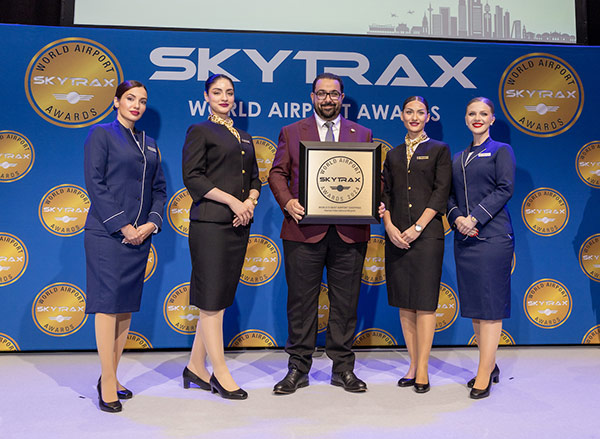EUROPE. Airport passenger traffic in Europe grew +2.2% year-on-year in September – down from +3.4% in August.
Airports Council International (ACI) Europe figures also showed a +2.6% year-on-year increase in the third quarter, down from +4.3% in the first half.

“The passenger traffic growth dynamic keeps softening,” said ACI Europe Director General Olivier Jankovec. “While these figures account for worsening macro-economic and trading conditions, they also reflect the fact that four European airlines went bust in September.
“More generally, Europe’s airports see airlines limiting capacity and network development and focusing on protecting their yields. That trend is getting more acute as we have entered the winter season – with the grounding of [Boeing aircraft] 737 MAX as well as air traffic management limitations clearly not helping.”
The impact of the bankruptcies of Aigle Azur, XL Airways, Thomas Cook and Adria Airways was mostly felt in the European Union (EU) market, where passenger traffic grew by +2%. This was the weakest monthly performance in six years, according to ACI Europe.
The airports most affected by these airline market exits included Ljubljana (-9.6%), Paris Orly (-9.4%), Fuerteventura (-9.2%), Glasgow (-7.7%), Las Palmas (-6.1%), Corfu (-4%), Newcastle (-3.7%), Kos (-3.3%), Tenerife South (-3.1%) and Heraklion (-2.7%).
Among EU national markets, Latvia (+11.4%) was the only one to achieve double-digit growth, while Estonia and Luxembourg (both +9.6%), Austria (+9%), Hungary (+8.6%), Poland and Malta (both +7.6%), Finland (+6.4%) and Portugal (+6.2%) still significantly outperformed the EU average.
At the other end of the spectrum, Slovenia (-9.6%), Bulgaria (-7.9%), Sweden (-2.1%), Slovakia (-1.1%), the UK (-0.7%) and Germany (-0.4%) all posted passenger traffic losses. Greece (+0.3%), Denmark (+0.5%) and Cyprus (+0.6%) recorded minimal growth.
Among capital and larger EU airports, Milan Malpensa (+33.5% ) was the strongest performer, helped by the closure of Milan Linate for runway refurbishments. Other strong risers were London City (+11.9%), Riga (+11.4%), London Luton (+10.7%), Vienna (+10.4%), Budapest (+8.6%), Lisbon (+7.3%), Madrid (+7.1%), Prague (+6.7%) and Helsinki (+6.6%).
Airports in the non-EU market saw passenger traffic rise by +3%, in September. Growth was largely driven by Ukraine (+28.8%), Armenia (+18.7%), North Macedonia (+16.5%), Albania and Serbia (both +13.7%).
Iceland (-34.2%) continued to be severely affected by the bankruptcy of Wow and other airlines’ capacity adjustments, with the latter also impacting Georgia (-9.9%). Meanwhile, Russia slightly outperformed the non-EU average (+3.4%) – and gains were rather limited in Switzerland (+0.6%), Turkey (+1.8%) and Norway (+2.3%).
The biggest non-EU passenger growth figures came from Kyiv Boryspil (+27.6%), Yerevan (+18.7%), Tirana (+13.7%), Belgrade and Skopje (both +11.9%) and Minsk (+11.2%).

The ‘Majors’ (top five European airports) remained weak in September at +1.2% (compared with +1.3% in August). Paris Charles de Gaulle achieved the best performance (+4.8%), becoming the busiest European airport during the month with more than 6.81 million passengers. Istanbul (+1.8%), Amsterdam Schiphol (+1.4%) and Frankfurt (+1.3%) grew at a much lower pace, while London Heathrow (-3%) was affected by industrial action at British Airways.
Smaller regional airports (with less than 5 million passengers per annum) significantly underperformed at -0.7%. ACI Europe said this “reflected once again the fragility of their markets when trading conditions deteriorate”.
Group top performers
In September, airports with more than 25 million passengers per year (Group 1), 10-25 million (Group 2), 5-10 million passengers (Group 3) and under 5 million passengers per year (Group 4) reported an average adjustments of +2.4%, +4.1%, +2.2% and +0.7% respectively.
Under this measure, the airports that reported the highest year-on-year increases in passenger traffic during September 2019 were:
GROUP 1: Vienna (+13.2%), Antalya (+12.5%), Moscow Sheremetyevo (+9.4%), Lisbon (+7.7%) and Madrid (+7.3%)
GROUP 2: Milan Malpensa (+26.2%), Kyiv Boryspil (+25.8%), Porto (+11.3%), Moscow Vnukovo (+8.9%) and London Luton (+8.4%)
GROUP 3: Krakow (+29.8%), Sevilla (+20.2%), Nantes (+16.8%), Bologna and Bordeaux (+13.1%) and Riga (+12.6%)
GROUP 4: Targu Mures (+113.5%), Ohrid (+53.8%), Turku (+52.9%), Kharkiv (+42.1%) and Nis (+39.9%)












